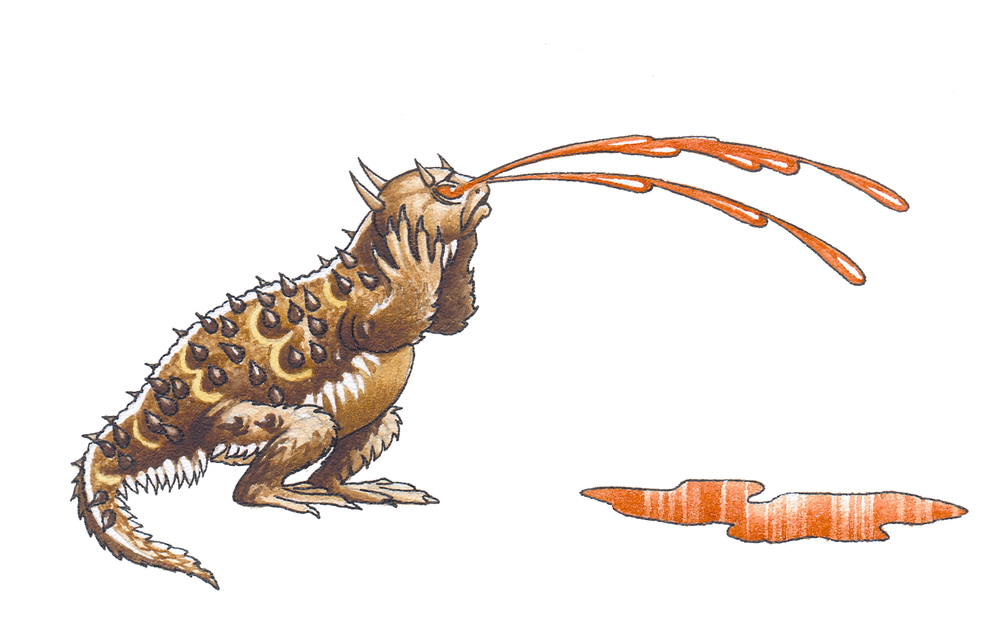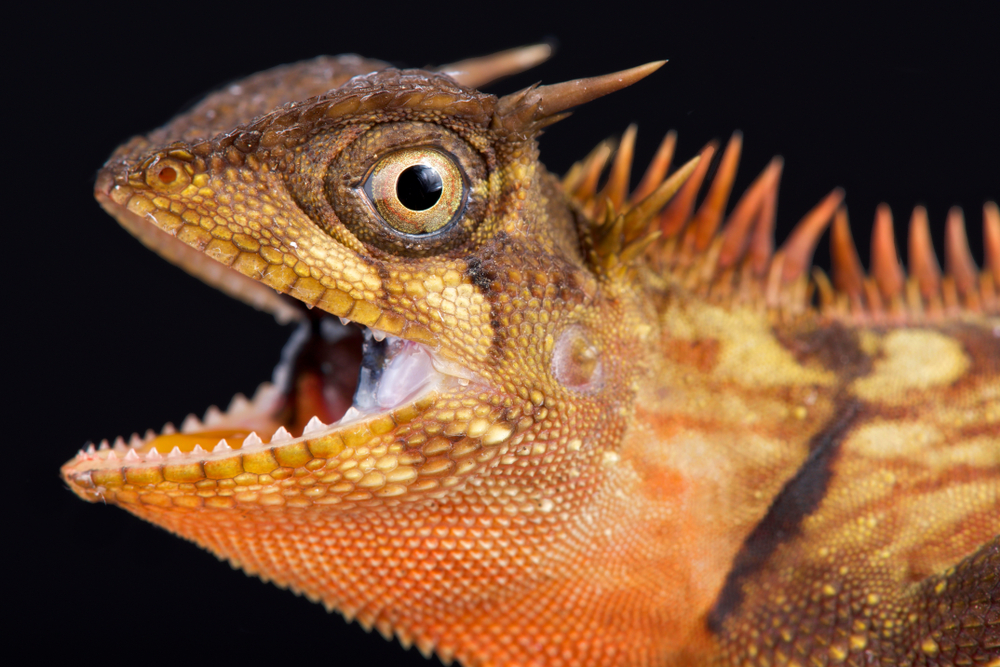Table of Contents (click to expand)
When camouflage or horns fail to work, the horned lizard resorts to squirting blood from its eyes, which usually does the trick and keeps predators at bay.
Do lizards creep you out? Wait until you see what some of them can do with their eyes.
Commonly known as horned lizards, these creatures can be characterized based on their flattened horns, rounded snouts, and bloated toad-like bodies. The lizards belong to the genus Phrynosoma. At least 8 species of this genus possess the ability to get bloody-eyed when necessary. However, P. mcallii, P. modestum, and P. platyrrhines are not blessed with this bizarre and rather grotesque trick.
A potential threat will cause them to squirt blood… straight out of their eyes!
But how does squirting blood from its eyes protect this unusual creature?
What’s Up With The Bloody Defense?
Every animal employs its own unique defense strategies to protect itself, and horned lizards are no different. They could make use of their horns and pierce them into the flesh of their captor to break free, but that isn’t always effective with larger predators.

They have also been observed to camouflage or flatten their bodies to escape detection.
Saving the best for last, when none of the aforementioned tactics work, this creature resorts to squirting blood from its eyes, which usually does the trick, and keeps predators at bay!

When animals voluntarily eject blood from their bodies, the act is referred to as auto-hemorrhaging. For the horned lizard, one of the primary motives to auto-hemorrhage is self-defense.
Several studies have investigated how these lizards respond to different predators and threats. Hawks and snakes are a common threat to this species. A few species of Phrynosoma squirted blood when they encountered canids (dog family) as well. However, some species showed no such response, failing to squirt blood in both canid and human encounters.
Worthy of mention are P. cornutum, P. coronatum, and P. solare, three species of horned toads that excel at auto-hemorrhaging.

Also Read: 6 Animals That Attack To Defend Themselves From Predators
Where Does The Blood Come From?
Ocular sinuses are directly connected to the blood vessels in the eye sockets of the lizard. When faced with a potential threat, the circulatory system of the head is immediately affected. Blood flow to the head becomes increasingly restricted, which causes the blood to redirect to the ocular sinuses, where the pressure builds up. This enables the oculi muscles adjacent to the pressured sinuses to contract. When the muscles contract, these sinuses rupture, and a stream of blood that had been held in the eye ducts shoots out, and can be ejected up to 5 feet!
These lizards can squirt blood repeatedly until they succeed in scaring off the aggressive predator.
Also Read: Is There An Evolutionary Advantage To Different Shapes Of Eye Pupils?
What’s In The Blood?
Simply squirting blood may not suffice. For the action to be fully effective, the blood must also be distasteful to the predator. Research has found some extra chemicals in the blood that act to deter predators. These chemical deterrents may already be present in the composition of the blood that is already circulating in the lizard’s body. The chemicals can have a foul smell or even ruin the appetite of their predators. Scientists aren’t exactly sure what the chemicals might be.
One hypothesis is that the chemical is derived from ant venom. Horned lizards like to gobble up venomous ants. The lizards can eat the ants unharmed because their seems to neutralize the ant venom.
Considering all of this, it’s interesting to note that horned lizards are not always seen with bloodshot eyes; how then do their eyes go back to looking normal?
How Do They Clean Up The Bloody Mess?
These lizards possess a third eyelid, one that is a transparent membrane lining the eye. This membranous eyelid is called the nictitating membrane and is found in all lizards. After a bloody rupture, the nictitating membrane convenientlys remove the blood as it sweeps across the entire surface of the eyeball, pushing the pellet-like debris to the rear corner of the eye. The excess blood is deftly disposed of or dropped sometime later.

A Final Word
Evolutionary studies suggest that the trait of blood-squirting was adopted and became widespread when lizards started facing predation pressure from dog species. The species of horned lizards that currently lack this trait must have lost the ability to do so in the course of evolution. However, the reasons for this loss remain a mystery.
Auto-hemorrhaging to defend oneself is not limited to horned-lizards. Some snake species, like dwarf boids, king snakes, and some species of long-nosed snakes, also squirt blood, not only from their eyes, but from their nostrils or cloacal (common genital, intestinal, and urinary tract) opening.
How well do you understand the article above!

References (click to expand)
- Sherbrooke, W. C., & Middendorf III, G. A. (2001, December). Blood-Squirting Variability in Horned Lizards (Phrynosoma). (C. Guyer, Ed.), Copeia. American Society of Ichthyologists and Herpetologists (ASIH).
- Heath, J. E. (1966, January). Venous Shunts in the Cephalic Sinuses of Horned Lizards. Physiological Zoology. University of Chicago Press.
- Sherbrooke, W. C., & Middendorf, G. A., III. (2004, August). Responses of Kit Foxes (Vulpes macrotis) to Antipredator Blood-Squirting and Blood of Texas Horned Lizards (Phrynosoma cornutum). (M. E. Douglas, Ed.), Copeia. American Society of Ichthyologists and Herpetologists (ASIH).
- Mirkin, S., Tucker, M. R., & Williams, D. A. (2021). Predation release of Texas horned lizards (Phrynosoma cornutum) living in small towns. Ecology and evolution, 11(10), 5355–5363. https://doi.org/10.1002/ece3.7426
- Middendorf, G. A., & Sherbrooke, W. C. (1992). Canid Elicitation of Blood-Squirting in a Horned Lizard (Phrynosoma cornutum). Copeia, 1992(2), 519–527. https://doi.org/10.2307/1446212
